Increasing Winter Precipitation over Arid Central Asia under Global Warming
Abstract
:1. Introduction
2. Data and Methodology
2.1. Study Area
2.2. Data
2.3. Methodology
3. Results
3.1. Spatial Distribution of Mean Annual Precipitation
3.2. Subregion Division and Seasonal Cycle of Precipitation
3.3. Variations in Precipitation from 1960–1991
3.4. Validations of the Four Gridded Datasets against Observational Data
3.5. Spatial and Temporal Variations of Precipitation from 1960–2013
4. Discussion
5. Conclusions
Acknowledgments
Author Contributions
Conflicts of Interest
References
- Gessner, U.; Naeimi, V.; Klein, I.; Kuenzer, C.; Klein, D.; Dech, S. The relationship between precipitation anomalies and satellite-derived vegetation activity in central Asia. Glob. Planet. Chang. 2013, 110, 74–87. [Google Scholar] [CrossRef]
- Knorr, W.; Schnitzler, K.G.; Govaerts, Y. The role of bright desert regions in shaping North African climate. Geophys. Res. Lett. 2001, 28, 3489–3492. [Google Scholar] [CrossRef]
- Xu, H.; Li, Y.; Xu, G.Q.; Zou, T. Ecophysiological response and morphological adjustment of two central asian desert shrubs towards variation in summer precipitation. Plant. Cell. Environ. 2007, 30, 399–409. [Google Scholar] [CrossRef] [PubMed]
- Folland, C.K.; Rayner, N.A.; Brown, S.J.; Smith, T.M.; Shen, S.S.P.; Parker, D.E.; Macadam, I.; Jones, P.D.; Jones, R.N.; Nicholls, N. Global temperature change and its uncertainties since 1861. Geophys. Res. Lett. 2001, 28, 2621–2624. [Google Scholar] [CrossRef]
- Stocker, T.F.; Qin, D.; Plattner, G.K.; Tignor, M.; Allen, S.K.; Boschung, J.; Nauels, A.; Xia, Y.; Bex, V.; Midgley, P.M. The Physical science basis. Contribution of Working Group I to the Fifth Assessment Report of the Intergovernmental Panel on Climate Change; Cambridge University Press: Cambridge, UK, 2013. [Google Scholar]
- Taikan, O.; Shinjiro, K. Global hydrological cycles and world water resources. Science 2006, 313, 1068–1072. [Google Scholar]
- Yohe, G.; Malone, E.; Brenkert, A.; Schlesinger, M.; Meij, H.; Xing, X.S.; Lee, D. A Synthetic Assessment of the Global Distribution of Vulnerability to Climate Change from the IPCC Perspective that Reflects Exposure and Adaptive Capacity. Available online: http://ciesin.columbia (accessed on 8 July 2006).
- Borovikova, L.N. Description of the State of the National Hydrometeorological Surveys and Concept for Their Future Development; Report No. 4 World Bank Program 2.1; Improvement of hydrometeorological surveys in Central Asia: Tashkent, Usbekistan, 1997. [Google Scholar]
- Schiemann, R.; Lüthi, D.; Vidale, P.L.; Schär, C. The precipitation climate of central Asia—Intercomparison of observational and numerical data sources in a remote semiarid region. Int. J. Climatol. 2008, 28, 295–314. [Google Scholar] [CrossRef]
- Small, E.E.; Giorgi, F.; Sloan, L.C. Regional climate model simulation of precipitation in central Asia: Mean and interannual variability. J. Geophys. Res. 1999, 104, 6563–6582. [Google Scholar] [CrossRef]
- Chen, F.H.; Huang, W.; Jin, L.Y.; Chen, J.H.; Wang, J.S. Spatiotemporal precipitation variations in the arid central Asia in the context of global warming. Sci. China Earth Sci. 2011, 54, 1812–1821. [Google Scholar] [CrossRef]
- Bothe, O.; Fraedrich, K.; Zhu, X.H. Precipitation climate of central Asia and the large-scale atmospheric circulation. Theor. Appl. Climatol. 2012, 108, 345–354. [Google Scholar] [CrossRef]
- Huang, Q.X.; Zhao, Y.; He, Q. Climatic characteristics in central Asia based on cru data. Arid Zone Res. 2013, 30, 396–403. [Google Scholar]
- Guo, H.; Chen, S.; Bao, A.M.; Hu, J.J.; Gebregiorgis, A.; Xue, X.W.; Zhang, X.H. Inter-comparison of high-resolution satellite precipitation products over central Asia. Remote Sens. Basel 2015, 7, 7181–7212. [Google Scholar] [CrossRef]
- Zhu, X.F.; Zhang, M.J.; Wang, S.J.; Qiang, F.; Zeng, T.; Ren, Z.G.; Dong, L. Comparison of monthly precipitation derived from high-resolution gridded datasets in arid Xinjiang, central Asia. Quatern. Int. 2015, 358, 160–170. [Google Scholar] [CrossRef]
- Hu, Z.Y.; Hu, Q.; Zhang, C.; Chen, X.; Li, Q.X. Evaluation of reanalysis, spatially-interpolated and satellite remotely-sensed precipitation datasets in Central Asia. J. Geophys. Res. Atmos. 2016. [Google Scholar] [CrossRef]
- Peterson, T.C.; Vose, R.S. An overview of the global historical climatology network temperature database. Bull. Am. Meteorol. Soci. 1997, 78, 2837–2849. [Google Scholar] [CrossRef]
- Harris, I.; Jones, P.D.; Osborn, T.J.; Lister, D.H. Updated high-resolution grids of monthly climatic observations - the cru ts3.10 dataset. Int. J. Climatol. 2014, 34, 623–642. [Google Scholar] [CrossRef] [Green Version]
- Rudolf, B.; Beck, C.; Grieser, J.; Schneider, U. Global Precipitation Analysis Products of the GPCC. Available online: http://www.juergen-grieser.de/publications/publications_pdf/GPCC-intro-products-2005.pdf (accessed on 16 October 2016).
- Schneider, U.; Becker, A.; Finger, P.; Meyer-Christoffer, A.; Rudolf, B.; Ziese, M. GPCC full data reanalysis version 7.0 at 0.5°: Monthly land-surface precipitation from rain-gauges built on GTS-based and historic data. Rep. Ger. Weather Serv. 2015. [Google Scholar] [CrossRef]
- Rienecker, M.M.; Suarez, M.J.; Gelaro, R.; Todling, R.; Bacmeister, J.; Liu, E.; Bosilovich, M.G.; Schubert, S.D.; Takacs, L.; Kim, G.K. Merra: Nasa’s modern-era retrospective analysis for research and applications. J. Clim. 2011, 24, 3624–3648. [Google Scholar] [CrossRef]
- Huffman, G.J.; Bolvin, D.T.; Nelkin, E.J.; Wolff, D.B.; Adler, R.F.; Gu, G.J.; Hong, Y.; Bowman, K.P.; Stocker, E.F. The TRMM Multisatellite Precipitation Analysis (TMPA): Quasi-global, multiyear, combined-sensor precipitation estimates at fine scales. J. Hydrometeorol. 2007, 8, 38–55. [Google Scholar] [CrossRef]
- Farlie, D.J.G. Rank correlation methods. J. R Stat. Soc. Ser. A-G 1971, 134, 682. [Google Scholar] [CrossRef]
- Hamed, K.H. Trend detection in hydrologic data: The Mann-Kendall trend test under the scaling hypothesis. J. Hydrol. 2008, 349, 350–363. [Google Scholar] [CrossRef]
- Yue, S.; Wang, C.Y. Applicability of prewhitening to eliminate the influence of serial correlation on the Mann-Kendall test. Water Res. Res. 2002, 38, 7. [Google Scholar] [CrossRef]
- Nicholson, S.E.; Some, B.; Mccollum, J.; Nelkin, E.; Klotter, D.; Berte, Y.; Diallo, B.M.; Gaye, I.; Kpabeba, G.; Ndiaye, O. Validation of TRMM and other rainfall estimates with a high-density gauge dataset for west Africa. Part i: Validation of GPCC rainfall product and pre-TRMM satellite and blended products. J. Appl. Meteorol. 2003, 42, 1337–1354. [Google Scholar] [CrossRef]
- Raziei, T.; Bordi, I.; Pereira, L.S. An application of GPCC and NCEP/NCAR datasets for drought variability analysis in Iran. Water Resour. Manag. 2011, 25, 1075–1086. [Google Scholar] [CrossRef]
- Adam, J.C.; Lettenmaier, D.P. Adjustment of global gridded precipitation for systematic bias. J. Geophys. Res. 2003, 108, 1414–1422. [Google Scholar] [CrossRef]
- Stocker, T.F.; Dahe, Q.; Plattner, G. Working Group I Contribution to the IPCC Fifth Assessment Report Climate Change 2013, the Physical Science Basis; Final draft underlying scientific-technical assessment IPCC: Bern, Switzerland, 2013. [Google Scholar]
- Held, I.M.; Soden, B.J. Robust responses of the hydrological cycle to global warming. J. Clim. 2006, 19, 5686–5699. [Google Scholar] [CrossRef]
- Allen, M.; Ingram, W.J. Constraints on future changes in climate and the hydrologic cycle. Nature 2002, 419, 224–232. [Google Scholar] [CrossRef] [PubMed]
- Dore, M.H.I. Climate change and changes in global precipitation patterns: What do we know? Environ. Int. 2005, 31, 1167–1181. [Google Scholar] [CrossRef] [PubMed]
- Greve, P.; Orlowsky, B.; Mueller, B.; Sheffield, J.; Reichstein, M.; Seneviratne, S.I. Corrigendum: Global assessment of trends in wetting and drying over land. Nat. Geosci. 2014, 7, 848–852. [Google Scholar] [CrossRef]
- Donat, M.G.; Lowry, A.L.; Alexander, L.V.; O’Gorman, P.A.; Maher, N. More extreme precipitation in the world’s dry and wet regions. Nat. Clim. Chang. 2016. [Google Scholar] [CrossRef]
- Lioubimtseva, E.; Cole, R. Uncertainties of climate change in arid environments of central Asia. Rev. Fish. Sci. 2006, 14, 29–49. [Google Scholar] [CrossRef]
- Dai, X.G.; Wang, P.; Zhang, K.J. A study on precipitation trend and fluctuation mechanism in northwestern china over the past 60 years. Acta Phys. Sin.-Ch. Ed. 2013, 62, 129201–129210. [Google Scholar]
- Li, B.F.; Chen, Y.N.; Chen, Z.S.; Xiong, H.G.; Lian, L.S. Why does precipitation in northwest china show a significant increasing trend from 1960 to 2010? Atmos. Res. 2016, 167, 275–284. [Google Scholar] [CrossRef]
- Jaramillo, F.; Destouni, G. Developing water change spectra and distinguishing change drivers worldwide. Geophys. Res. Lett. 2014, 41, 8377–8386. [Google Scholar] [CrossRef]
- Jaramillo, F.; Destouni, G. Local flow regulation and irrigation raise global human water consumption and footprint. Science 2015, 350, 1248–1251. [Google Scholar] [CrossRef] [PubMed]
- Han, Q.F.; Luo, G.P.; Bai, J.; Li, J.L.; Li, C.F.; Fan, B.B.; Wang, Y.G. Characteristics of land use and cover change in central Asia in recent 30 years. Arid Land Geogr. 2012, 35, 909–918. [Google Scholar]
- Wang, Y.G.; Luo, G.P.; Zhao, S.B.; Han, Q.F.; Li, C.F.; Fan, B.B.; Chen, Y.L. Effects of arable land change on regional carbon balance in Xinjiang. Acta. Geogr. Sin. 2014, 69, 110–120. [Google Scholar]
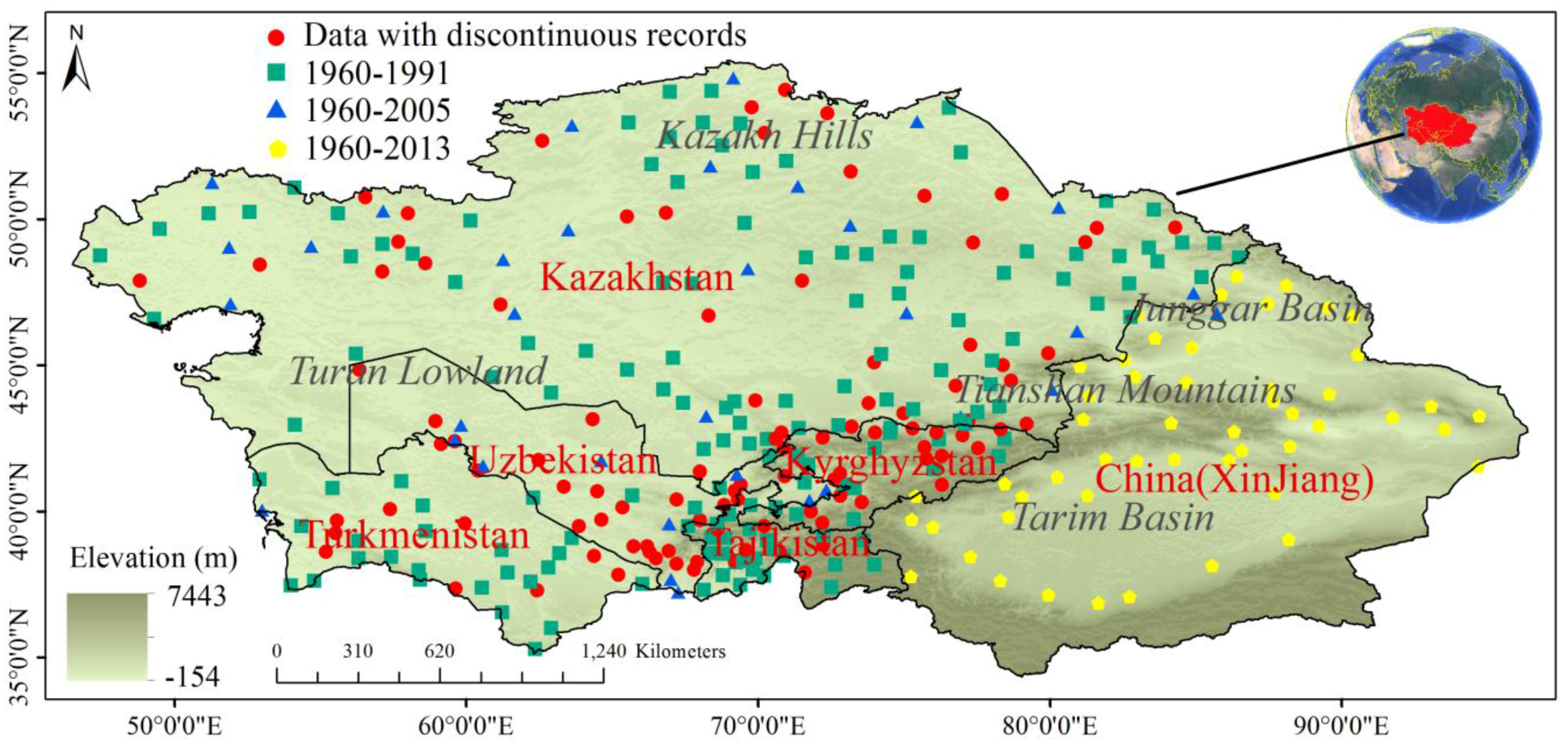
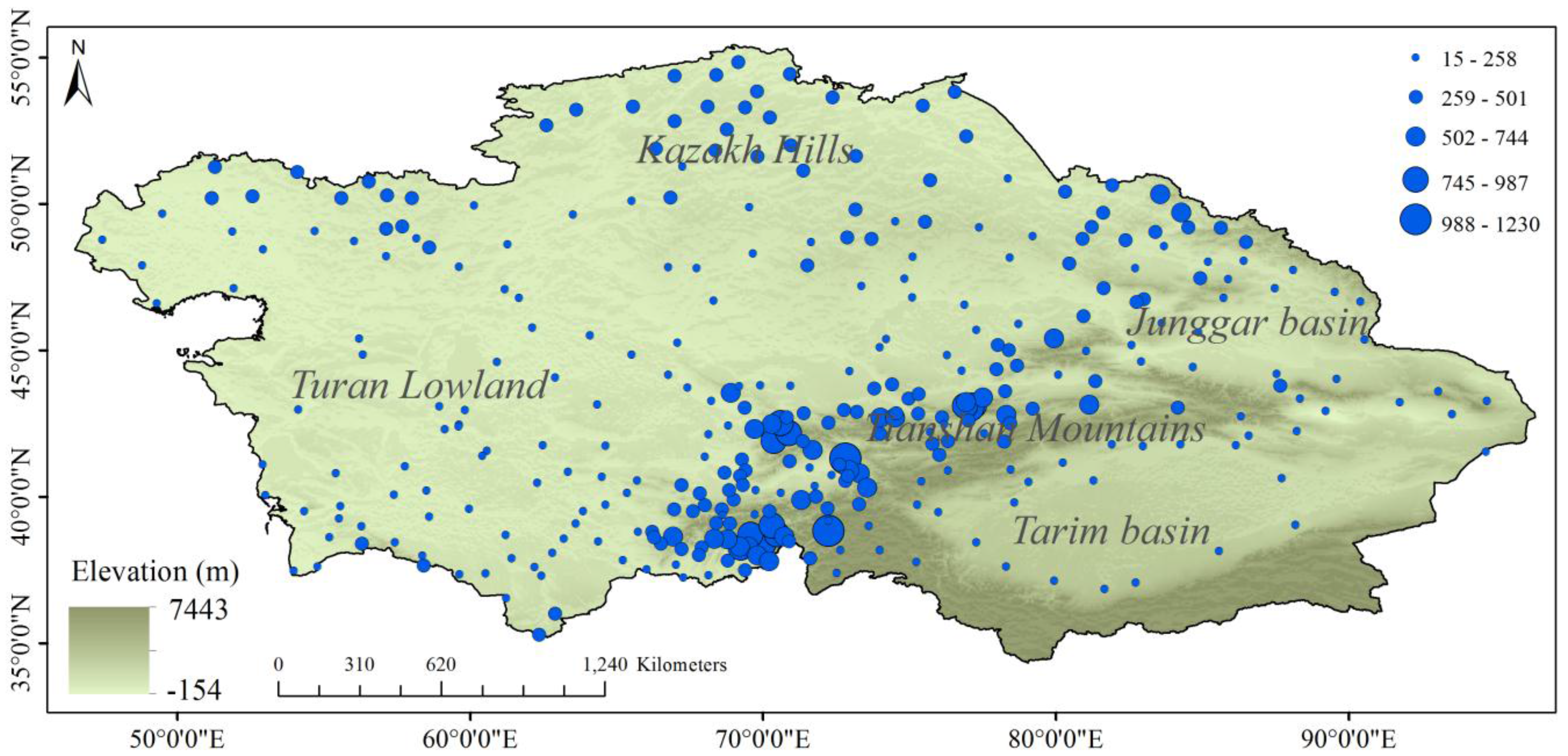
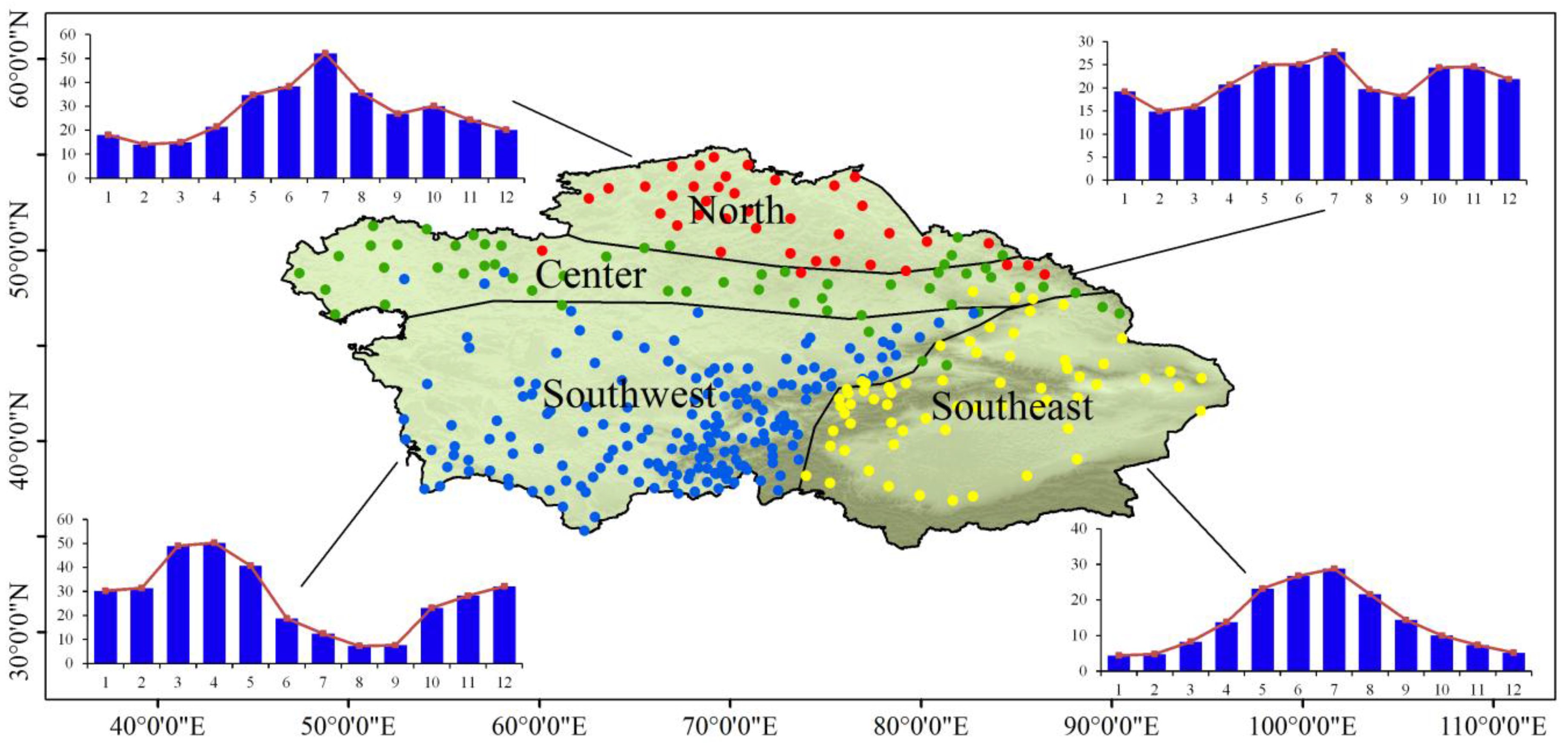
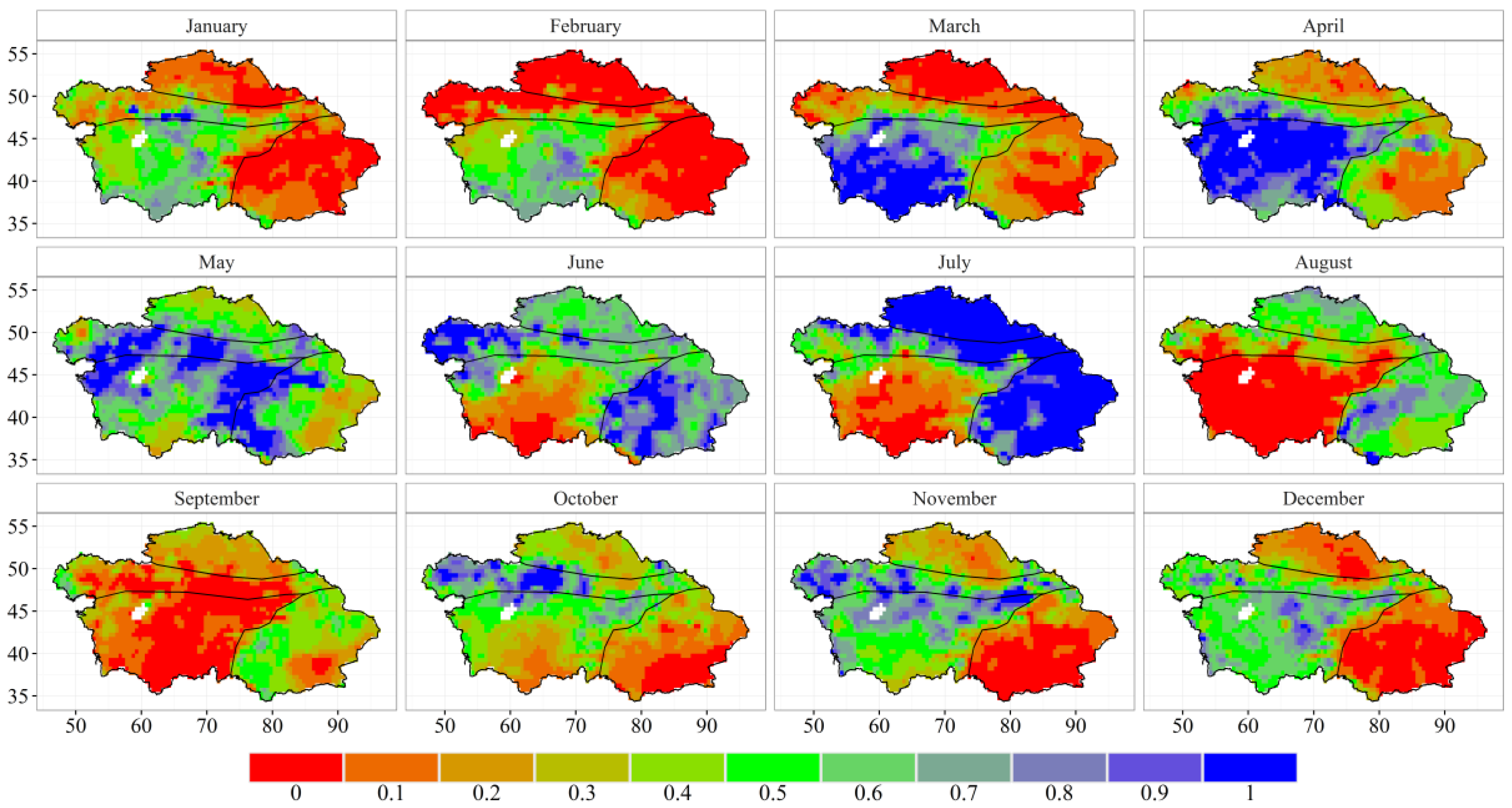
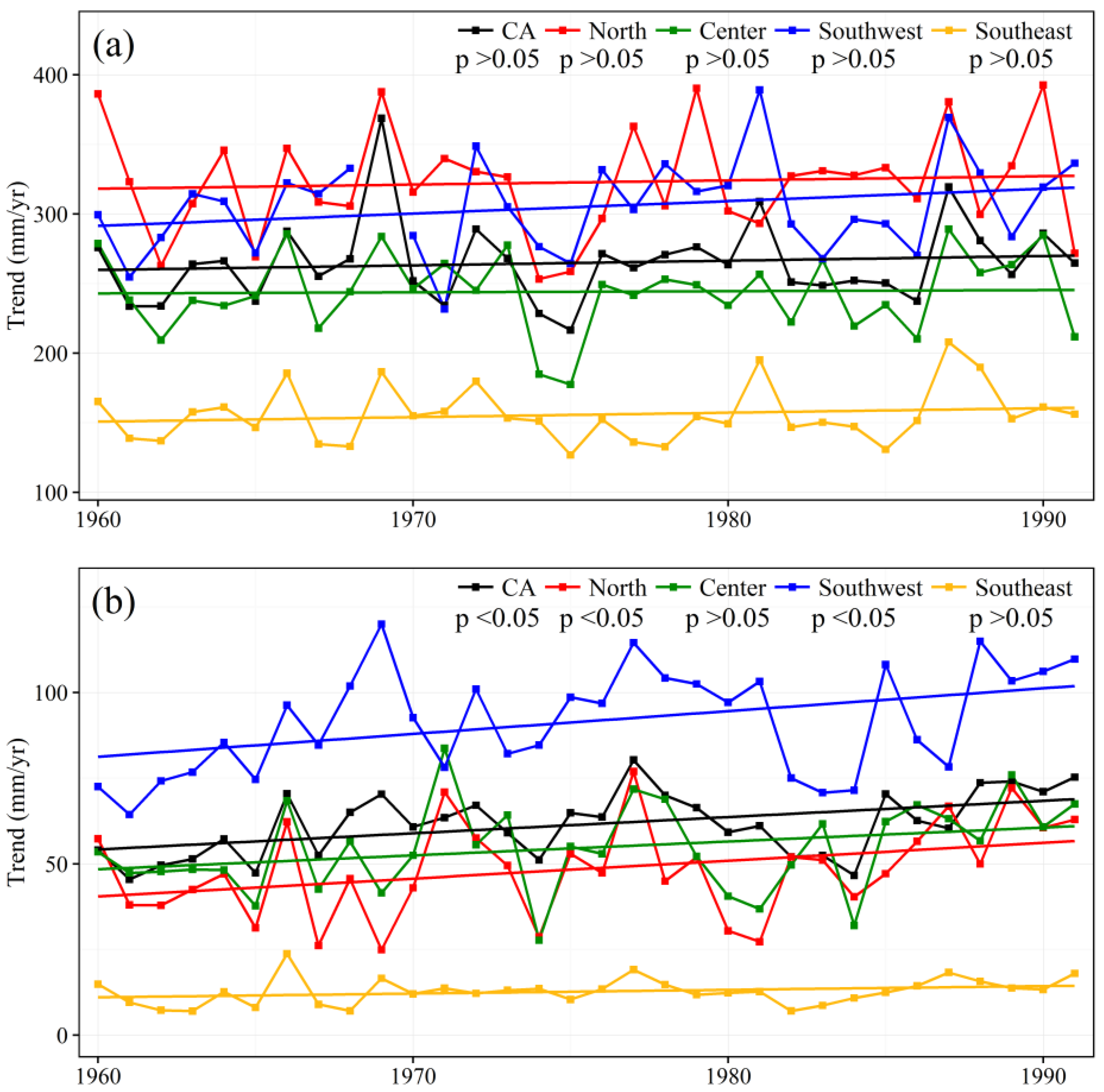
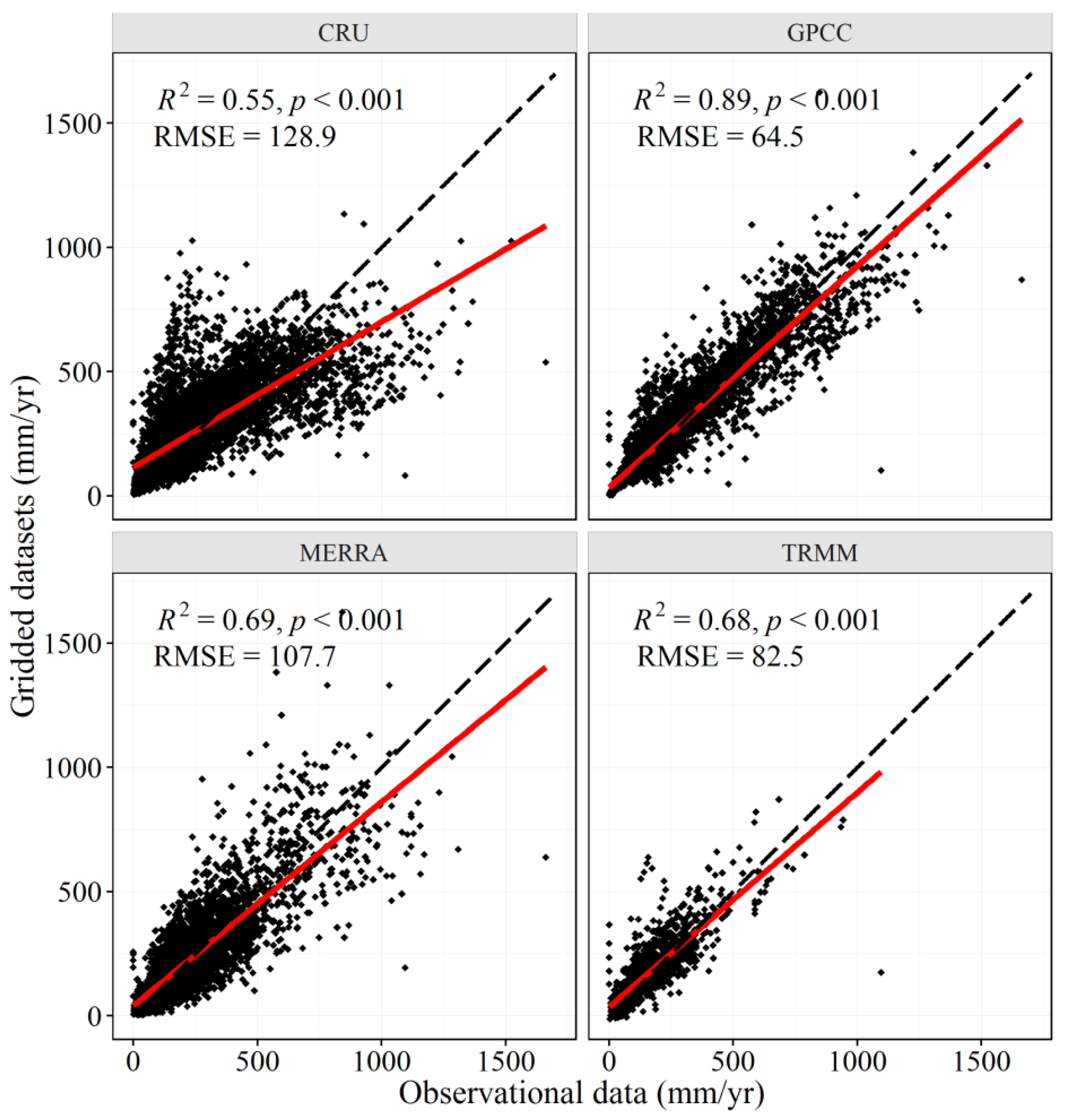
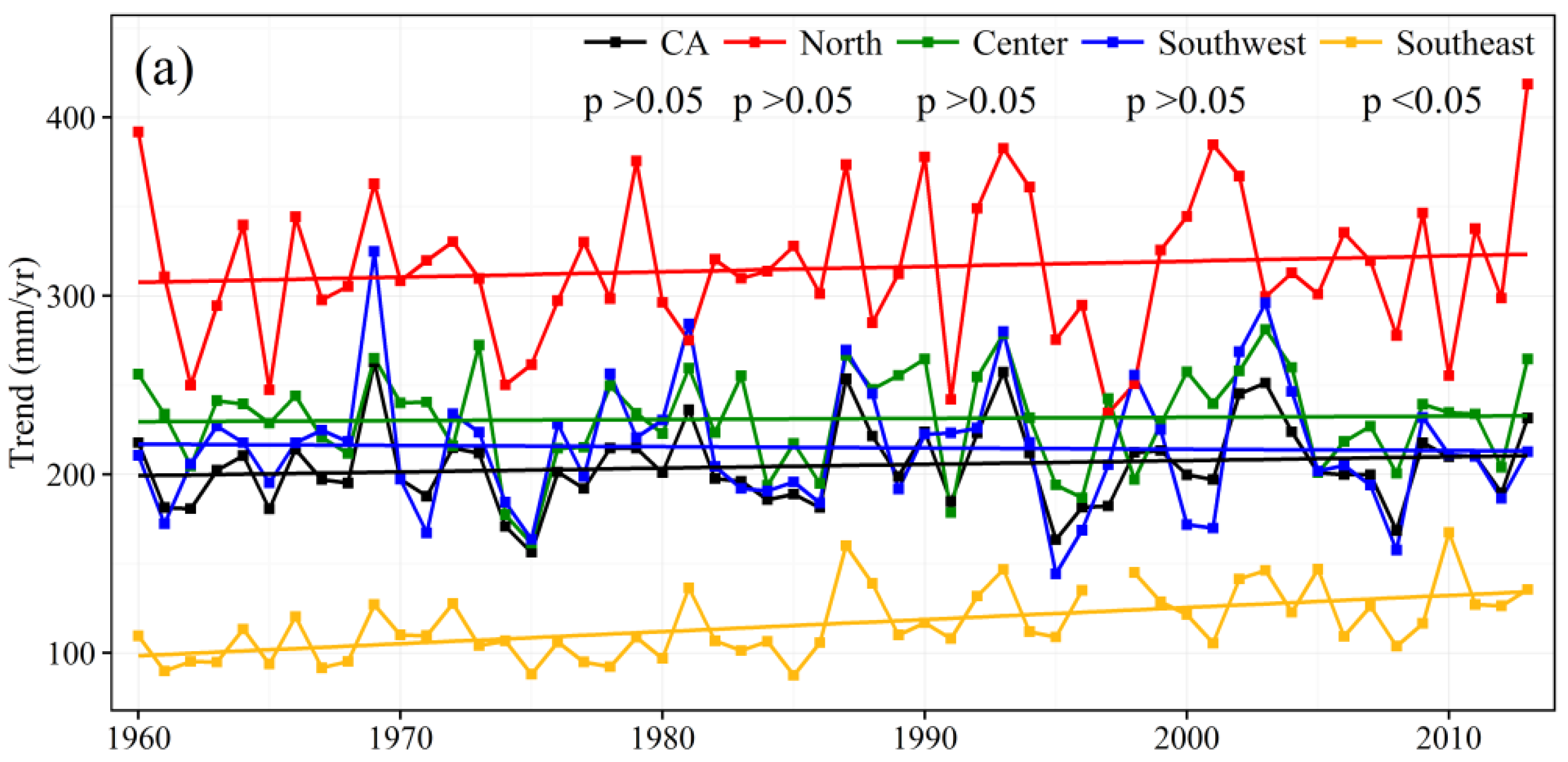
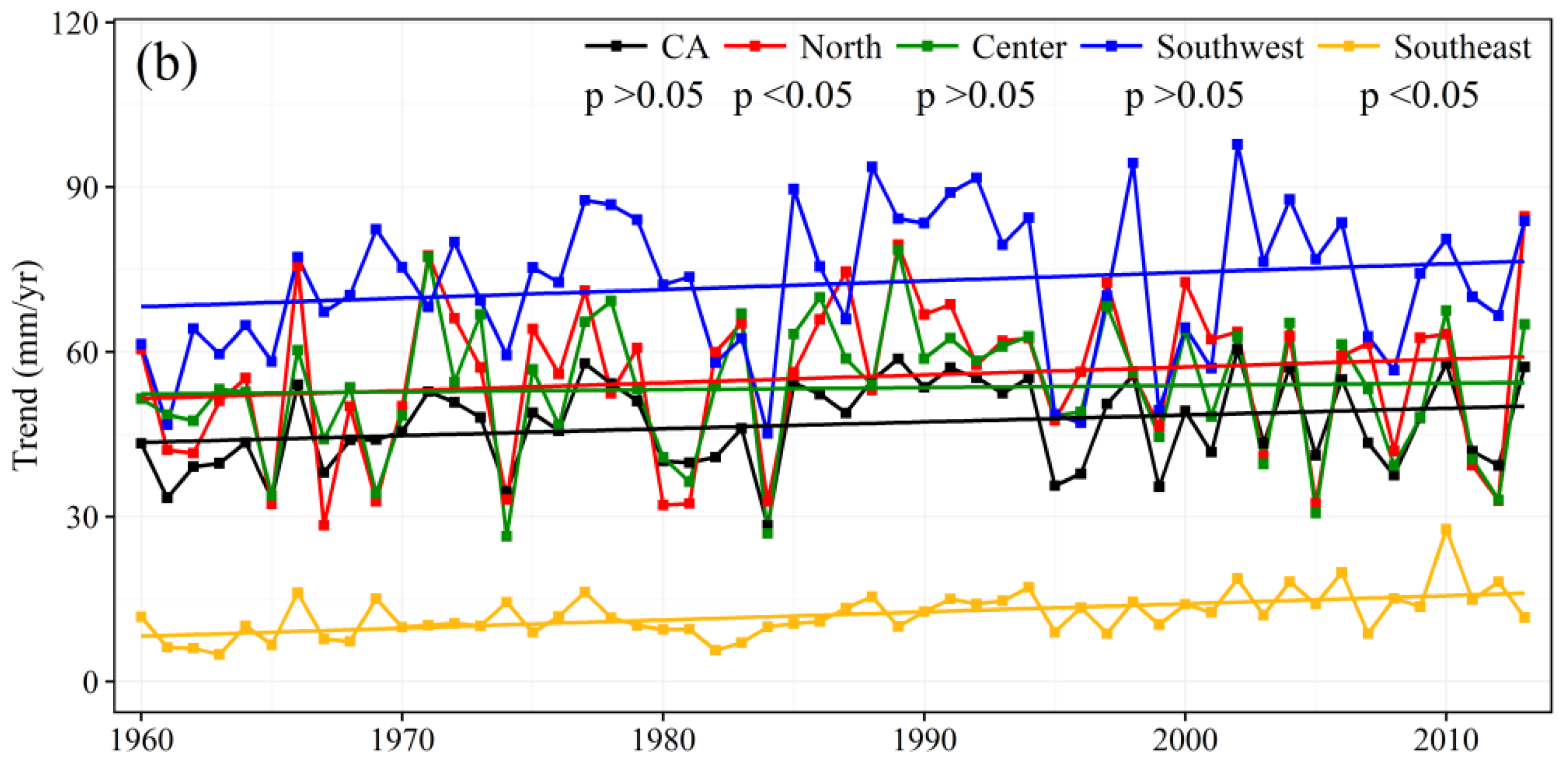
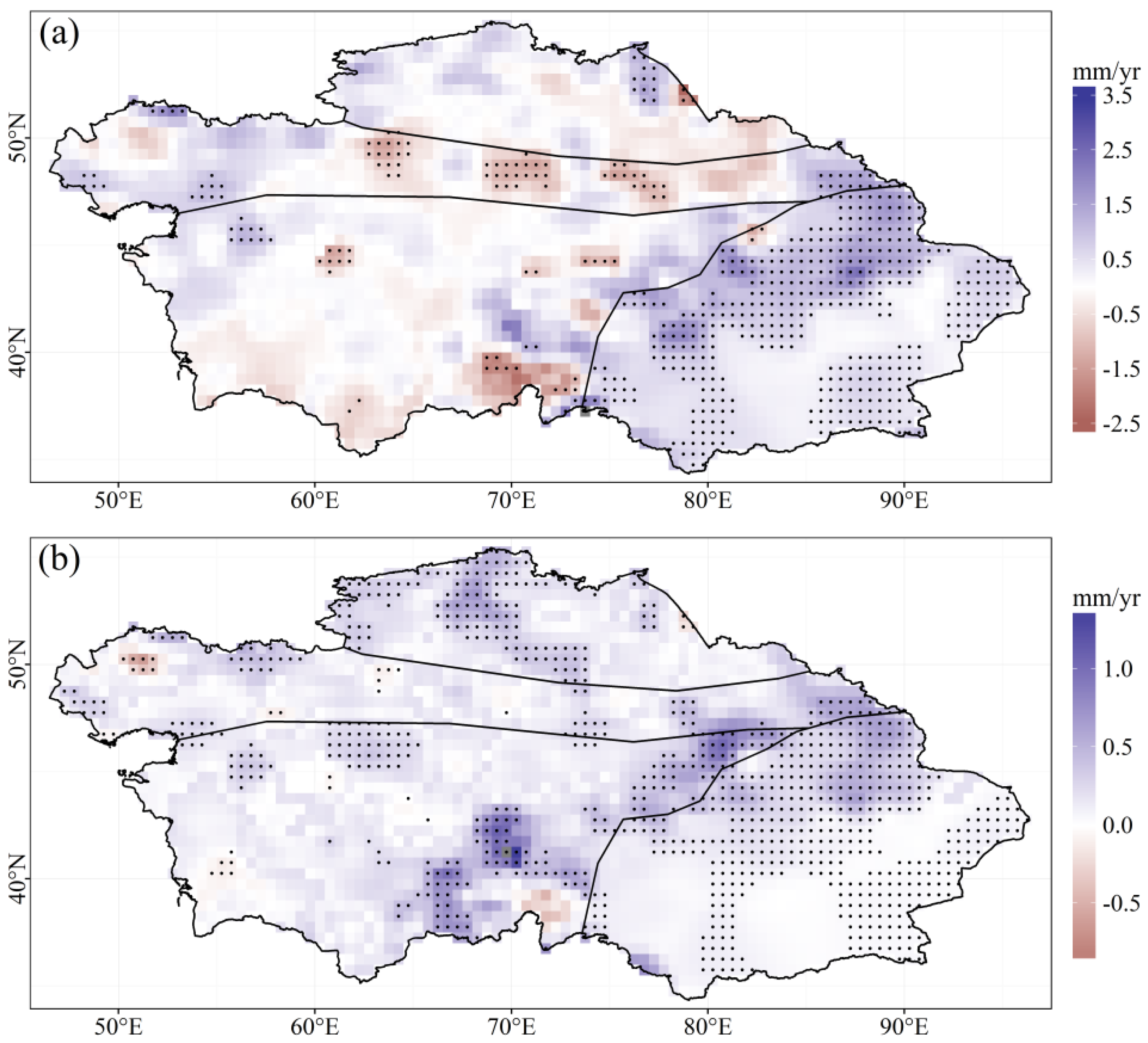
| Dataset | Version | Spatial Resolution | Time Span | Description and Data Source |
|---|---|---|---|---|
| Climate Research Unit (CRU) | TS3.10 | 0.5° × 0.5° | 1901–2013 | Angular distance-weighted (ADW) interpolation based on records from 4,000 meteorological stations. |
| Global Precipitation Climatology Centre (GPCC) | V7.0 | 0.5° × 0.5° | 1901–2013 | Interpolation based on quality controlled data from all stations in GPCC's data base available for the required month with a maximum number of 49,450 stations. |
| Modern Era Retrospective-Analysis for Research and Applications (MERRA) | V2.1 | 0.5° × 0.67° | 1979–2013 | NASA Re-analysis for the satellite era using a major new version of the Goddard Earth Observing System Data Assimilation System Version 5 (GEOS-5). |
| Tropical Rainfall Measuring Mission (TRMM) | V7.0 | 0.25° × 0.25° | 1998–2013 | TRMM satellite product. |
| Region | Annual | Spring | Summer | Autumn | Winter | |||||
|---|---|---|---|---|---|---|---|---|---|---|
| Slope | p | Slope | p | Slope | p | Slope | p | Slope | p | |
| CA | 0.33 | NS | −0.2 | NS | −0.11 | NS | 0.15 | NS | 0.49 | ** |
| North | 0.3 | NS | 0.16 | NS | −0.87 | NS | 0.47 | NS | 0.52 | * |
| Center | 0.08 | NS | −0.1 | NS | −0.3 | NS | 0.07 | NS | 0.4 | NS |
| Southwest | 0.45 | NS | −0.43 | NS | 0.06 | NS | 0.09 | NS | 0.67 | * |
| Southeast | 0.32 | NS | −0.03 | NS | 0.08 | NS | 0.16 | NS | 0.1 | NS |
| Region | Annual | Spring | Summer | Autumn | Winter | |||||
|---|---|---|---|---|---|---|---|---|---|---|
| Slope | p | Slope | p | Slope | p | Slope | p | Slope | p | |
| CA | 0.22 | NS | 0.04 | NS | 0.09 | NS | −0.03 | NS | 0.11 | * |
| North | 0.3 | NS | 0.29 | * | −0.05 | NS | −0.08 | NS | 0.13 | NS |
| Center | 0.06 | NS | 0.24 | * | −0.05 | NS | −0.16 | NS | 0.04 | NS |
| Southwest | −0.07 | NS | −0.22 | NS | 0.07 | NS | −0.06 | NS | 0.13 | NS |
| Southeast | 0.64 | *** | 0.16 | * | 0.27 | *** | 0.13 | ** | 0.13 | *** |
© 2016 by the authors; licensee MDPI, Basel, Switzerland. This article is an open access article distributed under the terms and conditions of the Creative Commons Attribution (CC-BY) license (http://creativecommons.org/licenses/by/4.0/).
Share and Cite
Song, S.; Bai, J. Increasing Winter Precipitation over Arid Central Asia under Global Warming. Atmosphere 2016, 7, 139. https://doi.org/10.3390/atmos7100139
Song S, Bai J. Increasing Winter Precipitation over Arid Central Asia under Global Warming. Atmosphere. 2016; 7(10):139. https://doi.org/10.3390/atmos7100139
Chicago/Turabian StyleSong, Shikai, and Jie Bai. 2016. "Increasing Winter Precipitation over Arid Central Asia under Global Warming" Atmosphere 7, no. 10: 139. https://doi.org/10.3390/atmos7100139
APA StyleSong, S., & Bai, J. (2016). Increasing Winter Precipitation over Arid Central Asia under Global Warming. Atmosphere, 7(10), 139. https://doi.org/10.3390/atmos7100139






